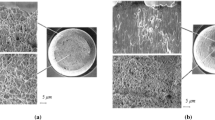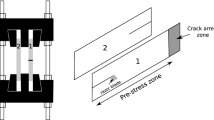Abstract
Thick shear bands in polystyrene formed by compression could cause fracture or the formation of cracks by intersecting with themselves, by relaxing after the removal of the load, by propagating all the way to the side surfaces and by subsequent tensile deformation. The microstructural mechanisms involved in all these fracture processes are discussed.
Similar content being viewed by others
References
J. B. C. Wu and J. C. M. Li, J. Mater. Sci. 11 (1976) 434.
C. C. Chau and J. C. M. Li, ibid. 14 (1979) 2172.
K. Friedrich and K. Schafer, ibid. 14 (1979) 480.
C. C. Chau and J. C. M. Li, ibid. 15 (1980) 1898.
L. Camwell and D. Hull, Phil. Mag. 27 (1973) 1135.
T. E. Brady and G. S. Y. Yeh, J. Mater. Sci. 8 (1973) 1083.
J. C. M. Li, Met. Trans. 9A (1978) 1353.
Author information
Authors and Affiliations
Rights and permissions
About this article
Cite this article
Chau, C.C., Li, J.C.M. Fracture of shear bands in atactic polystyrene. J Mater Sci 16, 1858–1873 (1981). https://doi.org/10.1007/BF00540634
Received:
Accepted:
Issue Date:
DOI: https://doi.org/10.1007/BF00540634




